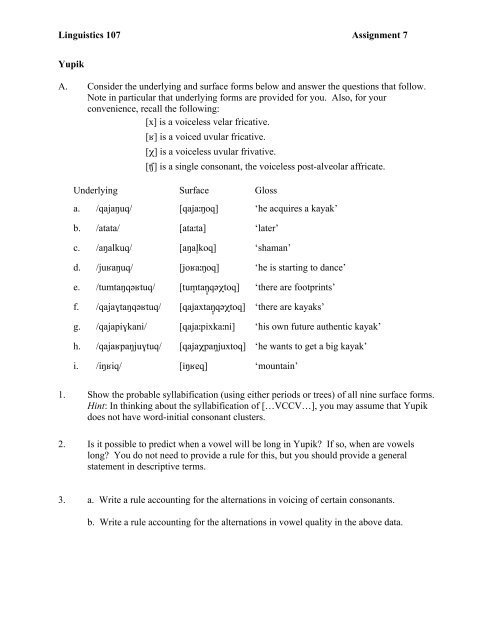Linguistics 107 Assignment 7 Yupik A. Consider ... - UCSB Linguistics
Linguistics 107 Assignment 7 Yupik A. Consider ... - UCSB Linguistics
Linguistics 107 Assignment 7 Yupik A. Consider ... - UCSB Linguistics
You also want an ePaper? Increase the reach of your titles
YUMPU automatically turns print PDFs into web optimized ePapers that Google loves.
<strong>Linguistics</strong> <strong>107</strong> <strong>Assignment</strong> 7<br />
<strong>Yupik</strong><br />
A. <strong>Consider</strong> the underlying and surface forms below and answer the questions that follow.<br />
Note in particular that underlying forms are provided for you. Also, for your<br />
convenience, recall the following:<br />
[x] is a voiceless velar fricative.<br />
[ʁ] is a voiced uvular fricative.<br />
[χ] is a voiceless uvular frivative.<br />
[ʧ] is a single consonant, the voiceless post-alveolar affricate.<br />
Underlying Surface Gloss<br />
a. /qajaŋuq/ [qajaːŋoq] ‘he acquires a kayak’<br />
b. /atata/ [ataːta] ‘later’<br />
c. /aŋalkuq/ [aŋal̥koq] ‘shaman’<br />
d. /juʁaŋuq/ [joʁaːŋoq] ‘he is starting to dance’<br />
e. /tumtaŋqəʁtuq/ [tum̥ taŋ̥qәχtoq] ‘there are footprints’<br />
f. /qajaɣtaŋqəʁtuq/ [qajaxtaŋ̥qәχtoq] ‘there are kayaks’<br />
g. /qajapiɣkani/ [qajaːpixkaːni] ‘his own future authentic kayak’<br />
h. /qajaʁpaŋjuɣtuq/ [qajaχpaŋjuxtoq] ‘he wants to get a big kayak’<br />
i. /iŋʁiq/ [iŋʁeq] ‘mountain’<br />
1. Show the probable syllabification (using either periods or trees) of all nine surface forms.<br />
Hint: In thinking about the syllabification of […VCCV…], you may assume that <strong>Yupik</strong><br />
does not have word-initial consonant clusters.<br />
2. Is it possible to predict when a vowel will be long in <strong>Yupik</strong>? If so, when are vowels<br />
long? You do not need to provide a rule for this, but you should provide a general<br />
statement in descriptive terms.<br />
3. a. Write a rule accounting for the alternations in voicing of certain consonants.<br />
b. Write a rule accounting for the alternations in vowel quality in the above data.
<strong>Linguistics</strong> <strong>107</strong> <strong>Assignment</strong> 7<br />
B. Now consider the following data, with attention to the occurrence of schwa, i.e. [ə]:<br />
Underlying Surface Gloss<br />
a. /qajaɣtaŋqәʁtuq/ [qajaxtaŋ̥qәχtoq] ‘there are kayaks’<br />
b. /navәɣtuq/ [navәxtoq] ‘it breaks’<br />
c. /aŋutәt/ [aŋuːtәt] ‘men’<br />
d. /aŋәluni/ [aŋluːni] ‘it being big’<br />
e. /atәpik/ [atpik] ‘real name’<br />
f. /qajaŋәʧiquq/ [qajaŋ̥ʧeqoq] ‘he will get a kayak’<br />
4. Schwa is deleted in some forms. Write a rule that accounts for the deletion of schwa in<br />
the above data. It may be useful to think about syllable structure.<br />
5. Assume your generalization from Question 2 may be restated as a formal rule predicting<br />
vowel length. Is the ordering of the vowel-length rule crucial with respect to your schwadeletion<br />
rule from Question 4? If so, in what order must they apply?<br />
Bonus1: Illustrate your answer to Question 5, using both possible orderings of the vowellength<br />
rule and the schwa-deletion rule, with derivations for [aŋluːni].<br />
Bonus2: Must the rule of schwa-deletion be ordered with respect to your devoicing rule<br />
from Question 3? If so, in what order must they apply? Illustrate your answer,<br />
using both possible orderings of these rules, with derivations for [qaˈjaŋ̥ʧeqoq].
















